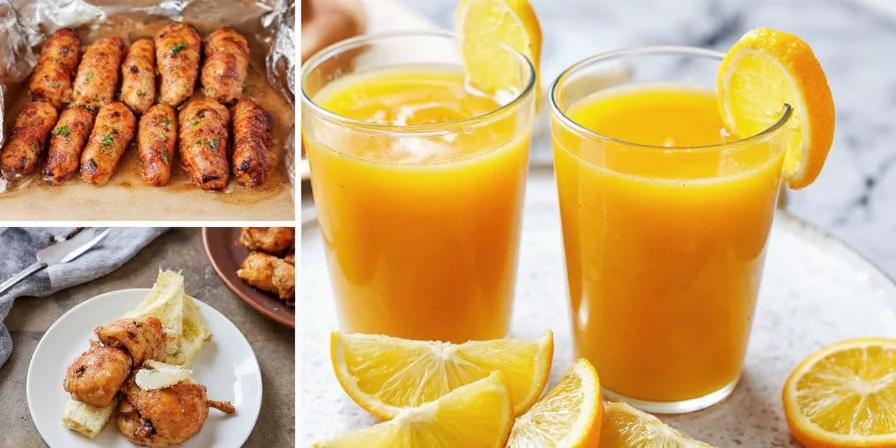Looking for the perfect orange glaze for your cake, ham, or bundt? You've found the ultimate collection of tested recipes that actually work. This guide delivers exactly what home bakers need: five simple but exceptional orange glaze recipes with clear instructions, plus practical tips that guarantee professional results every time. Skip the confusing science—get straight to the glazes that deliver bright citrus flavor without curdling, graininess, or disappointment.
Table of Contents
- Introduction
- Top 5 Orange Glaze Recipes That Actually Work
- Simple Flavor Boosters (No Chemistry Degree Required)
- How to Store Leftover Glaze Properly
- Conclusion
Top 5 Orange Glaze Recipes That Actually Work
These kitchen-tested recipes deliver perfect consistency and flavor every time. Each includes our pro tips for avoiding common mistakes like graininess, separation, or weak citrus flavor.
1. Foolproof Orange Powdered Sugar Glaze (Best for Cakes)

- 2 cups powdered sugar (sifted)
- 2–3 tbsp fresh orange juice
- 1 tsp orange zest
- Pinch of salt
Pro Tip: Use freshly squeezed juice for best flavor. If your glaze gets too thin, add more powdered sugar 1 tbsp at a time. Too thick? Add juice by the teaspoon. This basic glaze works perfectly on pound cakes, cinnamon rolls, and coffee cakes.
2. Easy Bourbon Orange Glaze (Best for Dense Cakes)

- 1½ cups powdered sugar
- 2 tbsp orange juice
- 1 tbsp bourbon
- 1 tsp vanilla extract
Pro Tip: The bourbon enhances orange flavor without making your dessert taste boozy (the alcohol cooks off). Perfect for carrot cake, spice cake, or bundt cakes. No bourbon? Substitute with orange extract.
3. Simple Maple-Citrus Drizzle (Best for Muffins & Scones)

- ¼ cup pure maple syrup
- 1 tbsp fresh orange juice
- 1 tsp orange zest
- ¼ tsp cinnamon
Pro Tip: Warm the maple syrup slightly before mixing for easier blending. This thinner glaze soaks beautifully into muffin tops and scones without making them soggy.
4. Chocolate-Orange Glaze (Best for Donuts & Pastries)

- ½ cup powdered sugar
- 2 tbsp cocoa powder
- 2 tbsp orange juice
- 1 tsp orange zest
Pro Tip: Sift the cocoa powder to prevent lumps. Dip donuts while warm for the perfect coating, or drizzle over cooled pastries. For extra shine, add ½ tsp light corn syrup.
5. Healthy Yogurt Orange Glaze (Best for Healthier Treats)

- ¾ cup plain Greek yogurt
- 2 tbsp honey
- 1 tbsp orange juice
- 1 tsp orange zest
Pro Tip: Strain the yogurt overnight for a thicker glaze. Perfect for drizzling over pancakes, waffles, or healthy muffins. For best results, apply just before serving.
Simple Flavor Boosters (No Chemistry Degree Required)
Transform your basic glaze with these kitchen-tested additions that actually work:
Cardamom Magic
- Add ⅛ tsp ground cardamom to any orange glaze
- Works especially well with yogurt and powdered sugar glazes
This Middle Eastern pairing creates a sophisticated flavor that makes your baking taste expensive. One pinch makes a noticeable difference.
Nutmeg Secret
- Grate fresh nutmeg directly into warm glaze
- Use only a tiny pinch (too much tastes bitter)
Freshly grated nutmeg (not pre-ground) adds warmth that complements orange perfectly, especially in fall and winter recipes.
Cayenne Trick
- Add just a tiny pinch (1/16 tsp) to chocolate-orange glaze
- Mix in after glaze has cooled slightly
This secret restaurant technique enhances sweetness without making things spicy. Try it on chocolate cake!
How to Store Leftover Glaze Properly
Most glazes keep well if stored correctly. Here's what actually works:
| Glaze Type | Room Temperature | Refrigerator | Freezer |
|---|---|---|---|
| Powdered Sugar Glaze | 2 hours (covered) | 5 days in airtight container | 1 month (thaw overnight in fridge) |
| Chocolate Glaze | 1 hour (covered) | 3 days (separate from baked goods) | Not recommended |
| Yogurt Glaze | Do not leave out | 2 days max | Do not freeze |
| Maple Glaze | 4 hours (covered) | 1 week | 2 months |
Reusing Leftover Glaze: If glaze thickens in the fridge, add orange juice by the ½ tsp until desired consistency returns. Always stir gently—don't whisk, which creates bubbles.
Conclusion
Creating perfect orange glaze doesn't require fancy equipment or food science knowledge—just these tested recipes and practical tips. Start with the basic powdered sugar version for most baked goods, then experiment with the variations as you gain confidence. Remember the golden rules: use fresh orange juice (not bottled), add zest for maximum flavor, and adjust thickness gradually. With these recipes in your toolkit, you'll never serve a bland or grainy orange glaze again. Your cakes, hams, and pastries deserve that bright citrus finish—and now you have the simple, reliable method to deliver it.
Frequently Asked Questions
Why does my orange glaze become grainy?
Graininess happens when sugar recrystallizes. Use fresh orange juice (bottled often causes issues), and make sure your powdered sugar is sifted. Mix slowly and add liquid gradually—too much juice too fast causes separation. If it gets grainy, gently warm the glaze while stirring until smooth.
Can I use bottled orange juice for glaze?
Freshly squeezed is always best, but in a pinch, use 100% pure orange juice (no added sugar). Bottled juice often contains stabilizers that can cause your glaze to separate or become grainy. For best results, stick with fresh oranges.
How do I make my orange glaze thicker/thinner?
To thicken: Add more powdered sugar, 1 tablespoon at a time. To thin: Add orange juice by the teaspoon. Always adjust gradually—thinner is easier to fix than too thick! For chocolate glaze, a tiny bit of milk works better than juice for thinning.
What's the best orange glaze for ham?
Use the basic powdered sugar glaze but add 2 tbsp brown sugar and 1 tbsp Dijon mustard. The brown sugar creates beautiful caramelization when baked, and the mustard adds depth without making it taste spicy. Apply during the last 30 minutes of cooking.











 浙公网安备
33010002000092号
浙公网安备
33010002000092号 浙B2-20120091-4
浙B2-20120091-4